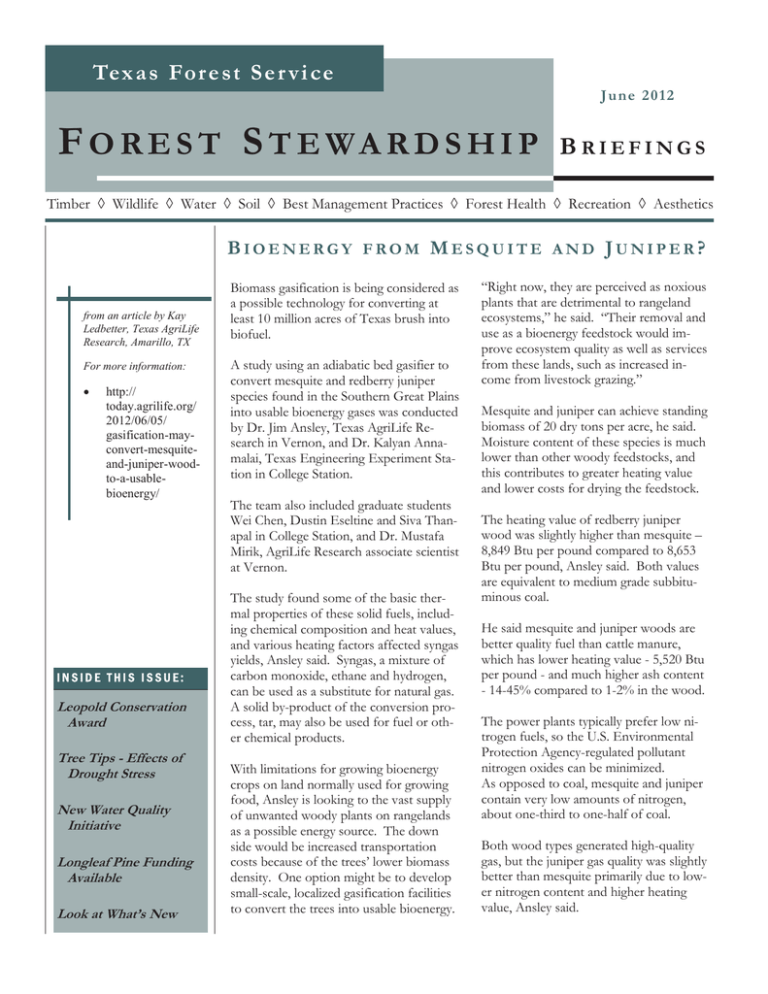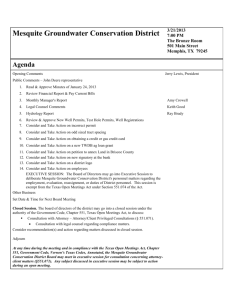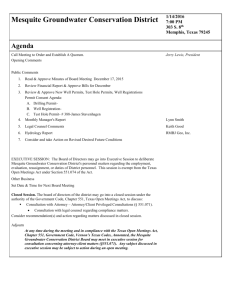Texas For est Ser vice
advertisement

Te x a s Fo r e s t S e r v i c e J u ne 2 0 1 2 FOREST STEWARDSHIP BRIEFINGS Timber ◊ Wildlife ◊ Water ◊ Soil ◊ Best Management Practices ◊ Forest Health ◊ Recreation ◊ Aesthetics BIOENERGY from an article by Kay Ledbetter, Texas AgriLife Research, Amarillo, TX For more information: http:// today.agrilife.org/ 2012/06/05/ gasification-mayconvert-mesquiteand-juniper-woodto-a-usablebioenergy/ INSIDE THIS ISSUE: Leopold Conservation Award Tree Tips - Effects of Drought Stress New Water Quality Initiative Longleaf Pine Funding Available Look at What’s New FROM MESQUITE Biomass gasification is being considered as a possible technology for converting at least 10 million acres of Texas brush into biofuel. A study using an adiabatic bed gasifier to convert mesquite and redberry juniper species found in the Southern Great Plains into usable bioenergy gases was conducted by Dr. Jim Ansley, Texas AgriLife Research in Vernon, and Dr. Kalyan Annamalai, Texas Engineering Experiment Station in College Station. The team also included graduate students Wei Chen, Dustin Eseltine and Siva Thanapal in College Station, and Dr. Mustafa Mirik, AgriLife Research associate scientist at Vernon. The study found some of the basic thermal properties of these solid fuels, including chemical composition and heat values, and various heating factors affected syngas yields, Ansley said. Syngas, a mixture of carbon monoxide, ethane and hydrogen, can be used as a substitute for natural gas. A solid by-product of the conversion process, tar, may also be used for fuel or other chemical products. With limitations for growing bioenergy crops on land normally used for growing food, Ansley is looking to the vast supply of unwanted woody plants on rangelands as a possible energy source. The down side would be increased transportation costs because of the trees’ lower biomass density. One option might be to develop small-scale, localized gasification facilities to convert the trees into usable bioenergy. AND JUNIPER? “Right now, they are perceived as noxious plants that are detrimental to rangeland ecosystems,” he said. “Their removal and use as a bioenergy feedstock would improve ecosystem quality as well as services from these lands, such as increased income from livestock grazing.” Mesquite and juniper can achieve standing biomass of 20 dry tons per acre, he said. Moisture content of these species is much lower than other woody feedstocks, and this contributes to greater heating value and lower costs for drying the feedstock. The heating value of redberry juniper wood was slightly higher than mesquite – 8,849 Btu per pound compared to 8,653 Btu per pound, Ansley said. Both values are equivalent to medium grade subbituminous coal. He said mesquite and juniper woods are better quality fuel than cattle manure, which has lower heating value - 5,520 Btu per pound - and much higher ash content - 14-45% compared to 1-2% in the wood. The power plants typically prefer low nitrogen fuels, so the U.S. Environmental Protection Agency-regulated pollutant nitrogen oxides can be minimized. As opposed to coal, mesquite and juniper contain very low amounts of nitrogen, about one-third to one-half of coal. Both wood types generated high-quality gas, but the juniper gas quality was slightly better than mesquite primarily due to lower nitrogen content and higher heating value, Ansley said. P ag e 2 T e xa s F o r e st Ser v ic e L E O P O L D C O N S E RVA T I O N A W A R D from Sand County Foundation and Texas Parks and Wildlife publications For more information: http:// lcablog.org/2012/ cooks-branchconservancyreceives-leopoldconservationaward/ http:// www.tpwd.state.tx. us/landwater/land/ private/ lone_star_land_ste ward/ The transformation of a clear-cut, overgrazed working ranch into Cook’s Branch Conservancy a century later has earned a prominent Texas family the 2012 Leopold Conservation Award, the state’s highest honor recognizing habitat management and wildlife conservation on private land. The George Mitchell family’s Cook’s Branch Conservancy, which consists of 5,650 acres near Montgomery, north of Houston, has been managed for nearly 50 years under a family tradition of conservation and sustainability. The Mitchells practice adaptive management, changing plans every three years based on monitoring, current environmental conditions, and other factors. This allows for adaptation to changing conditions and provides documented responses to management activities for future reference. Some of the Mitchell family’s conservation practices include continuous timber monitoring, selective thinning to ensure uneven aged pine-dominated upland forest with a healthy representation of sub-dominant tree species, and pre- scribed burning to rid the property of unwanted growth while enhancing native ground cover. Water resources at Cook’s Branch have been improved through the establishment of streamside management zones, planting approximately 2,000 hardwoods in formerly clear-cut riparian areas, development of a groundwater quality monitoring site, and implementation and maintenance of impoundments to reduce erosion and provide wildlife and fisheries habitat. “The Mitchell family made a commitment many years ago to demonstrate that private landowners and federal land management agencies in East Texas can support and grow habitat suitable for use by the federally endangered red-cockaded woodpecker through the use of sound forest management practices,” said Jeff Reid of the U.S. Fish and Wildlife Service. “Such management practices have also increased the habitat suitability for bobwhite quail, eastern wild turkey, white-tailed deer, and myriad migratory bird species.” TREE TIPS - EFFECTS OF DROUGHT STRESS from Texas Forest Service website For more information: http://texasforest service.tamu.edu/ main/popup.aspx? id=1283 Immediate effects of drought on hardwood trees are usually obvious, but delayed effects also occur. Plants store food reserves and prepare for the next growing season during the current growing season. The effects of last year’s drought will carry over to the current growing season, and maybe beyond. Hardwood trees display numerous symptoms related to water stress. Wilting of leaves is a common indication of water stress. Wilting can be classified as incipient, temporary, or permanent. Incipient wilting is not readily noticeable, but it can change to temporary wilting which is characterized by visible drooping of the leaves during the day. At night the plant will rehydrate and recover from temporary wilting. During prolonged dry periods, temporary wilting can change to permanent wilting where the plant does not recover during the overnight period. Permanently wilted plants may recover when water is added to the soil, but prolonged permanent wilting usually kills most species of plants. Keep in mind there is great variation in wilting among different tree species and different types of soils. In addition to wilting, leaves may curl or warp, become crinkly, turn brown along the edges (scorch), turn yellow, turn brown, and/or fall from the tree. F o r e s t St ew ar d sh ip Br ie fin g s P ag e 3 N E W W A T E R Q UA L I T Y I N I T I A T I V E A national water quality initiative will provide $2.8 million in funding to farmers, ranchers and timberland owners along a major watershed of the Trinity River Basin to encourage conservation practices that will have a positive impact on Texas' rivers, lakes and streams. The new plan from the U.S. Department of Agriculture's Natural Resources Conservation Service is voluntary, though federal, state and local soil and water conservationists said it is critical. The Trinity River Basin is the most populated river basin in the state and provides water for more than 40 percent of Texas' population - nearly 8 million people. The agency's proposed practices include better ways of dealing with fertilizers and pesticides and encouraging prescribed grazing, field borders, cover crops and reduced tillage to lessen erosion. Another proposed suggestion to help stop erosion and increase the amount of clean rainwater that runs off into rivers and lakes calls for restoring native grasslands in rural watershed areas. Gary and Sue Price, who are recipients of the 2007 Leopold Conservation Award and the 2012 Outstanding Rangeland Stewardship Award, have found that the deeply-rooted native grasses on their land absorb rainfall, helping to recharge underground aquifers and reduce runoff. from an article by Linda Stewart Ball, The Associated Press, dated May 17, 2012 For more information: The Natural Resources Conservation Service plan covers 152,309 acres of seven sub-watersheds, known collectively as the Chambers Creek Watershed. It was targeted because of the high levels of sediments, chemicals and other pollutants. The Chambers Creek Watershed is a subwatershed of the Trinity River Basin, whose headwaters begin north of DallasFort Worth and run south through Houston and into the Galveston Bay outlet. http:// www.statesman. com/news/texas/ officials-detail-new -water-qualityinitiative2360814.html http://the-back40.com/2012/newwater-qualityinitiative-rolled-out -in-texas/ http:// trinitywaters.org/ L O N G L E A F P I N E F U N D I N G A VA I L A B L E The USDA Natural Resources Conservation Service (NRCS) announces additional funding availability through the Longleaf Pine Initiative to implement conservation practices that will maintain, improve, and restore Texas’ longleaf pine ecosystem. Offered through the Environmental Quality Incentives Program (EQIP), approved participants will receive financial assistance from NRCS for implementing conservation practices to improve the health and extent of the longleaf pine ecosystem. Eligible conservation practices include firebreaks, forest site preparation, forest stand improvement, prescribed burning, and tree/shrub establishment. “We’ve taken great steps toward conserving longleaf pine forests in Texas,” said NRCS State Conservationist Salvador Salinas. “Through this initiative and the great work of our landowners, we will be able to enhance and protect more of this essential habitat.” The deadline for applying for the additional funds is July 27, 2012 by Beverly Moseley, Public Affairs Specialist, USDA NRCS, Bryan, TX For more information: Highest priority will be given to land suitable for tree production in the following counties: Anderson, Angelina, Cherokee, Hardin, Houston, Jasper, Liberty, Montgomery, Nacogdoches, Newton, Polk, Sabine, San Augustine, San Jacinto, Shelby, Trinity, Tyler and Walker. Land outside these counties that is determined to be suitable for longleaf pine production will also be considered. Producers are encouraged to visit their local USDA Service Center office about this funding opportunity. These offices are listed in phonebooks under federal and state government, or online at www.tx.nrcs.usda.gov. www.tx.nrcs.usda.g ov/programs/whip/ whip_src/ longleaf_pine.html http:// www.nrcs.usda.gov /Internet/ FSE_DOCUMENT S/stelprdb 1045845.pdf Distribution of this newsletter is provided free of charge to professional foresters, state and federal agency professionals, county judges and commissioners, state senators and representatives, various forestry-related associations, and others. PLEASE ADVISE US IF YOU WISH YOUR NAME REMOVED FROM OUR MAILING LIST. This newsletter is also available on the web at http:// texasforestservice.tamu.edu/main/article.aspx? id=1183. If you would rather receive this newsletter electronically (by e-mail) or if you would like e-mail notification when a new issue is available at our web site, contact us at the address, phone number or email address above. The Texas Forest Service is an Affirmative Action/Equal Opportunity Employer committed to Excellence through Diversity. Editorial Board Rusty Wood, TPWD, Nacogdoches, Texas Joe Pase, TFS, Lufkin, Texas LOOK AT WHAT’S NEW Estate Planning and Taxation Workshop August 10, 2012 9:00 a.m. - 3:00 p.m. Nacogdoches, Texas There are special rules for forestry estate planning; some of them may not be known by tax professionals or the private landowner. This workshop is designed for forest landowners, consultants, accountants, attorneys, and others who work with forest landowners in matters pertaining to estate planning and timber taxes. Register online at www.texasforestry.org, or mail registration (listing name, address, phone, number of attendees) and payment of $35 (includes workbook and lunch) to Texas Forestry Association, P. O. Box 1488, Lufkin, TX 75902-1488. CEUs available. * * * * * * * Water Resources Blog Texas Forest Service’s Water Resources Program has a new blog where you can keep updated on what is going on with the program and read articles on Best Management Practices and other water related issues and events. Join us at http://tfswater.blogspot.com to find a wealth of information all in one spot! Phone: 936-639-8180 Email: dwork@tfs.tamu.edu P. O. Box 310 Lufkin, TX 75902-0310 TDD Line: 1-866-419-4872


